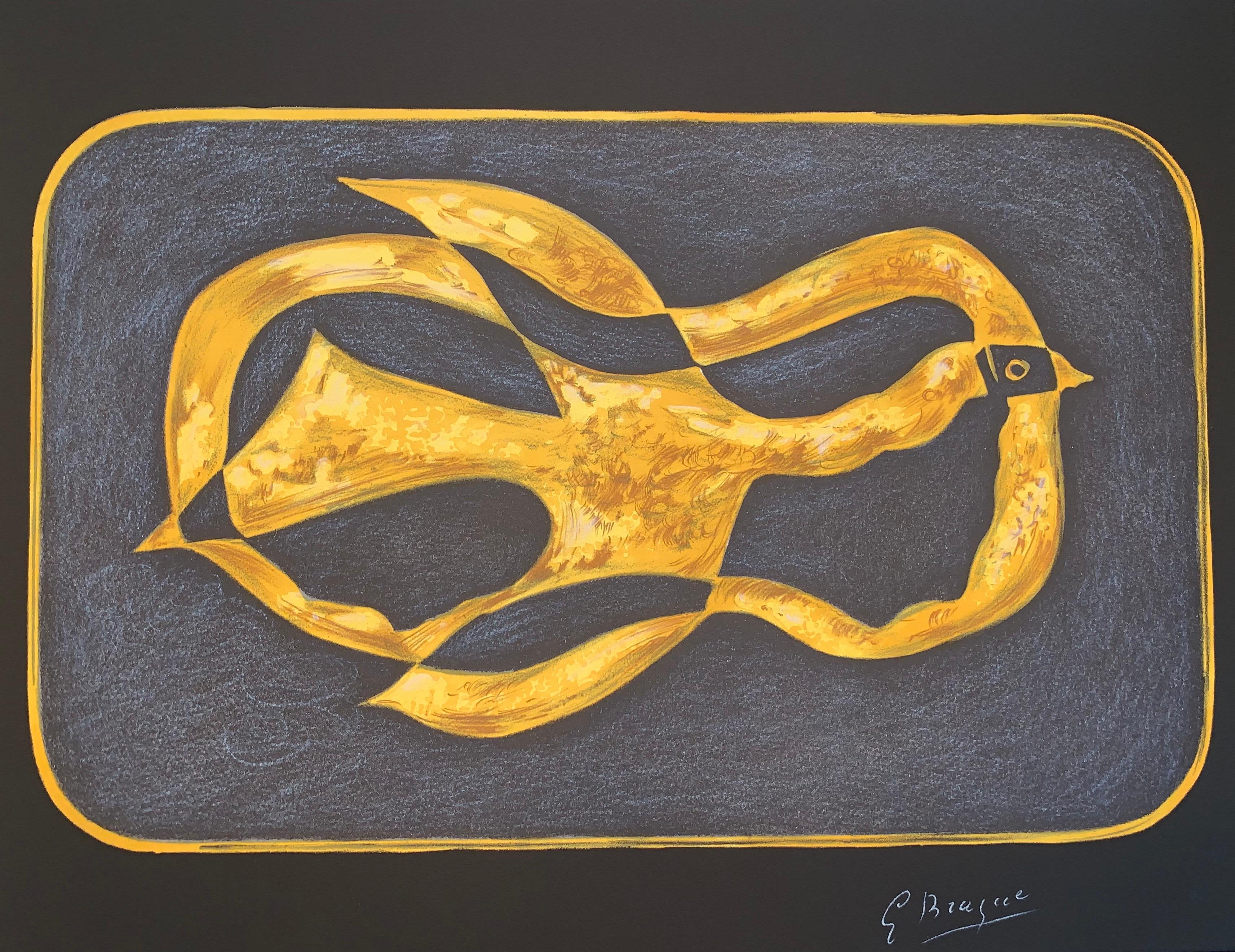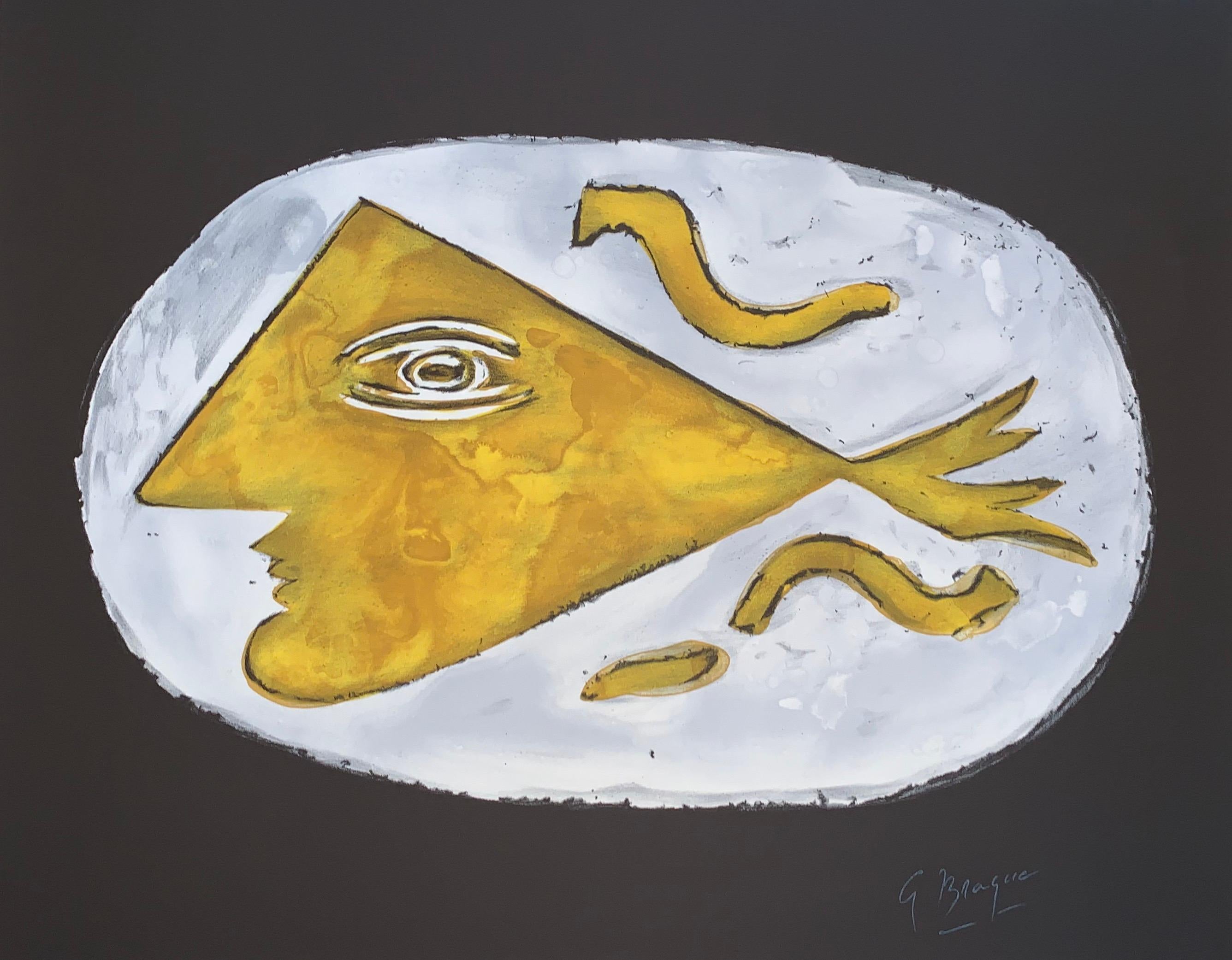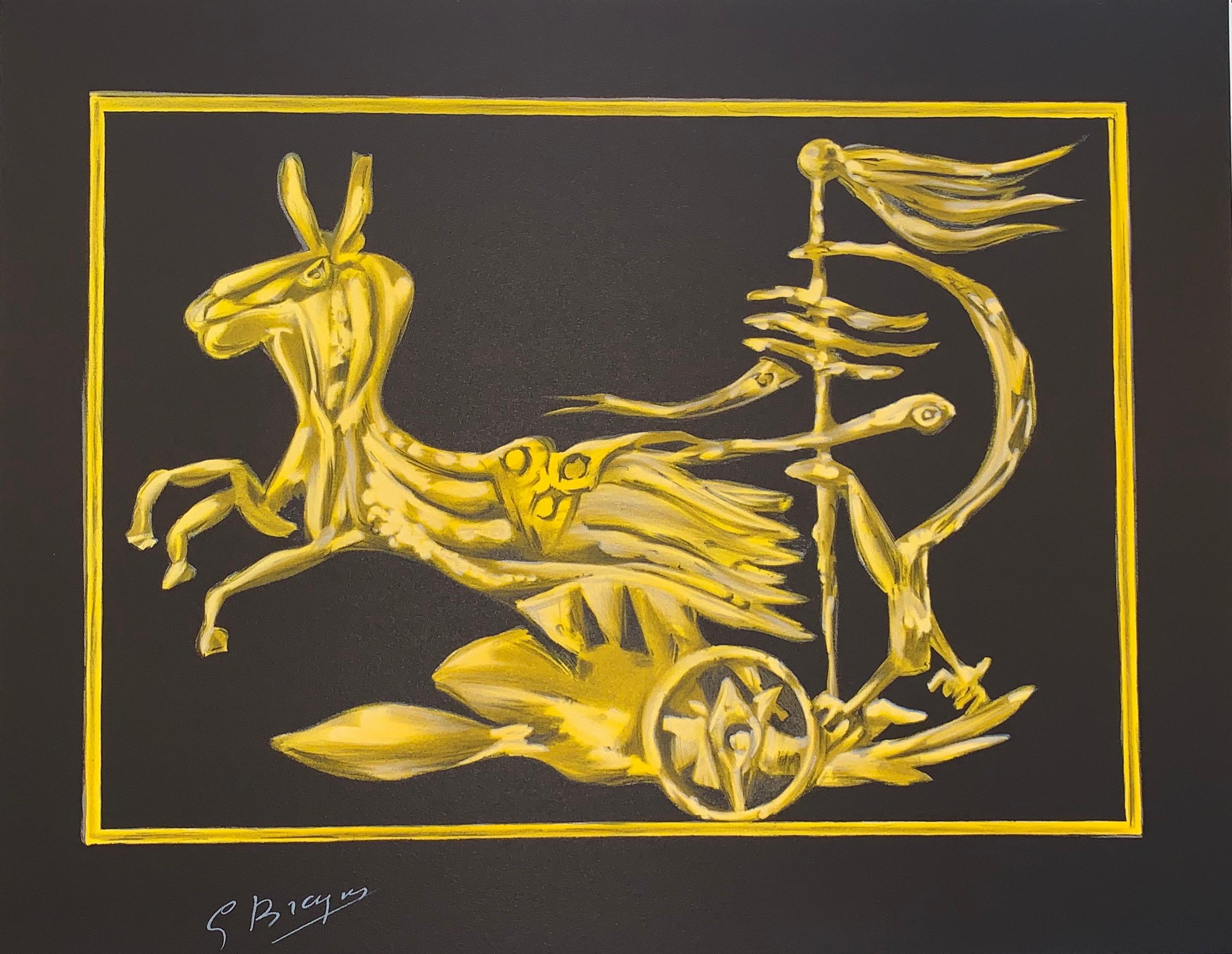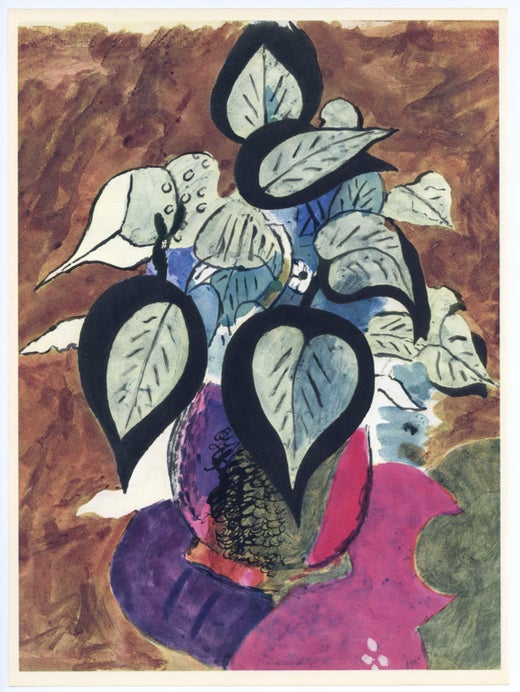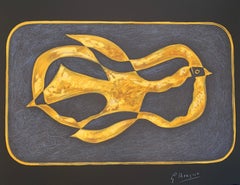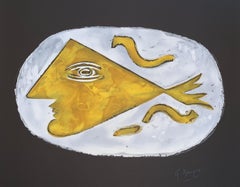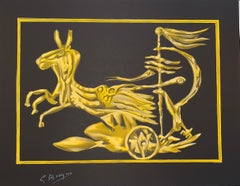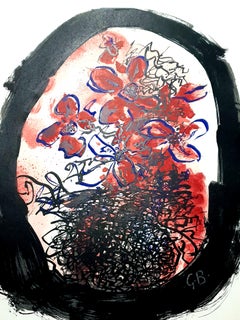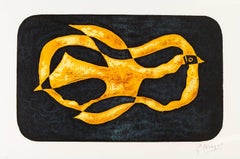Items Similar to Séléné - after Georges Braque - Lithograph - 1988 - Figurative Print
Want more images or videos?
Request additional images or videos from the seller
1 of 8
(after) Georges BraqueSéléné - after Georges Braque - Lithograph - 1988 - Figurative Print1988
1988
$417.36
£312.18
€350
CA$576.62
A$628.74
CHF 333.67
MX$7,601.28
NOK 4,222.80
SEK 3,870.78
DKK 2,666.42
About the Item
Color lithograph after a gouache by Georges Braque from the edition of 398 published by Armand & Georges Israel in 1988. Printed signature.
Artwork entirely made in France: from the production of the Vélin d’Arches paper in Arches in the Vosges department, to the traditional lithographic printing process, one drawing for each different color, one color per press run.
From the set of 12 color lithographs portfolio "Les Métamorphoses de Braque".
- Creator:(after) Georges Braque (1882 - 1963, French)
- Creation Year:1988
- Dimensions:Height: 17.72 in (45 cm)Width: 22.84 in (58 cm)
- Medium:
- Movement & Style:
- Period:
- Condition:
- Gallery Location:Sint-Truiden, BE
- Reference Number:1stDibs: LU114814107502
(after) Georges Braque
Braque began his artistic career painting in a Fauvist style, strongly influenced by friends Raoul Dufy and Henri Matisse. In 1907, however, after befriending Pablo Picasso, Braque began focusing on Cubist compositions and a more muted color palette. He and Picasso would work closely until 1914 when Picasso began focusing on symbolism and portraiture, while Braque sought to explore “pure composition” void of meaning and symbolism. A 1922 exhibition at the Salon d’Automne in Paris launched Braque further into fame. He won several important prizes over the next few decades, including First Prize at the Carnegie International and the main prize for painting at the Venice Biennale. In 1961, Braque became the first living artist to ever have his work displayed at The Louvre. Throughout the 1930s and 40s, Braque created many works featuring Greek and Roman mythological imagery such as this print, though his hope was to use the images simply as visual objects stripped of their histories, lore, and symbolism.
About the Seller
5.0
Vetted Professional Seller
Every seller passes strict standards for authenticity and reliability
Established in 2019
1stDibs seller since 2019
136 sales on 1stDibs
- ShippingRetrieving quote...Shipping from: Sint-Truiden, Belgium
- Return Policy
More From This Seller
View AllBoréade - after Georges Braque - Lithograph - 1988 - Figurative Print
By (after) Georges Braque
Located in Sint-Truiden, BE
Color lithograph after a gouache by Georges Braque from the edition of 398 published by Armand & Georges Israel in 1988. Printed signature.
Artwork en...
Category
1980s Cubist Figurative Prints
Materials
Lithograph
Hera - after Georges Braque - Lithograph - 1988 - Figurative Print
By (after) Georges Braque
Located in Sint-Truiden, BE
Color lithograph after a gouache by Georges Braque from the edition of 398 published by Armand & Georges Israel in 1988. Printed signature.
Artwork en...
Category
1980s Cubist Figurative Prints
Materials
Lithograph
Aegle - after Georges Braque - Lithograph - 1988 - Figurative Print
By (after) Georges Braque
Located in Sint-Truiden, BE
Color lithograph after a gouache by Georges Braque from the edition of 398 published by Armand & Georges Israel in 1988. Printed signature.
Artwork en...
Category
1980s Cubist Figurative Prints
Materials
Lithograph
Le Char De Médée - after Georges Braque - Lithograph - 1988 - Figurative Print
By (after) Georges Braque
Located in Sint-Truiden, BE
Color lithograph after a gouache by Georges Braque from the edition of 398 published by Armand & Georges Israel in 1988. Printed signature.
Artwork entirely made in France: from th...
Category
1980s Cubist Figurative Prints
Materials
Lithograph
Hébé - after Georges Braque - Lithograph - 1988 - Figurative Print
By (after) Georges Braque
Located in Sint-Truiden, BE
Color lithograph after a gouache by Georges Braque from the edition of 398 published by Armand & Georges Israel in 1988. Printed signature.
Artwork en...
Category
1980s Modern Figurative Prints
Materials
Lithograph
Phaeton - after Georges Braque - Lithograph - 1988 - Figurative Print
By (after) Georges Braque
Located in Sint-Truiden, BE
Color lithograph after a gouache by Georges Braque from the edition of 398 published by Armand & Georges Israel in 1988. Printed signature.
Artwork en...
Category
1980s Cubist Figurative Prints
Materials
Lithograph
You May Also Like
The Moon - Lithograph (399 copies)
By (after) Georges Braque
Located in Paris, IDF
Georges BRAQUE (after)
The Moon
MEDIUM : Lithograph
PRINTER : Atelier Art-Litho
EDITOR : Armand ISRAEL, Paris
SIGNATURE : Printed
LIMITED : 399 copies unumbered
PAPER : Arches vellu...
Category
Late 20th Century Modern Figurative Prints
Materials
Lithograph
Georges Braque - Original Lithograph
By Georges Braque
Located in Collonge Bellerive, Geneve, CH
Georges Braque - Original Lithograph
1963
Dimensions: 32 x 24 cm
Andre Sauret, Monte Carlo
The father of Cubism
Three Cubist that distinguishes art historian periods were initiated and developed by Georges Braque: The Cubist Cézanne (1907-1909), Executive (1909-1912) and synthetic (1912-1922).
Post-Impressionist and fawn, Braque no longer adheres to the contingency of a decorative way or the other. Cézanne’s paintings exhibited at the Grand Palais during the retrospective of 1907 are a revelation: Cézanne sought and invented a pictorial language. In his footsteps, Braque went to the South with the reasons of the Master. He returned with Estaque landscapes and surprising Ciotat it keeps Cezanne geometric model and retains the “passages” continuity from one surface to another to create the sensation of “turning around” of the object represented. But he wants to go after the consequences of the vision of Cezanne. In his paintings Houses in L’Estaque (1908) it simplifies the volumes of houses, neglects detail by removing doors and windows: the plastic rhythm that builds the table. Large Nude , a masterpiece of the period, can be considered the first work of Cézanne cubism .
Systematizing and deepening Braque discoveries open the door analytical cubism. In 1909, his painting became more cerebral than sensual. The pattern is recreated in the two-dimensionality of the canvas, leaving aside any illusionistic perspective. In Still Life with Violin, objects are analyzed facets according to their characteristic elements, each facet referring to a particular view of the object. There are so many facets of points selected view: Table reflects the knowledge of the object and the ubiquity of the eye. Moreover, Braque is looking for the essence of the objects in the world rather than their contingency, which explains the absence of light source and use of muted colors (gray, ocher), contingent aspects of the object . But formal logic has stepped facets, erased any anecdote to the object and ultimately led to his painting a hermetic more marked on the edge of abstraction (see the series of Castle Roche-Guyon ).
Braque, anxious to keep the concrete and refusing at all costs that the logic of Cubism takes the paintings to abstract, reintroduced signs of reality in his paintings in 1912 marks the beginning of Synthetic Cubism. Historians speak of “signs of real” rather than reality because what interests Braque, this is not to put reality into a table, but to create a painting which, by its language, refers to the real. To do this, he invented two major techniques XX th century inclusions and contributions. The inclusions consist of painting objects that have no real depth, materials (wallpaper in Nature morte aux playing cards faux wood is a pictorial inclusion) or letters (calligraphic inclusion in Portuguese ), made first brush and a few months later stencil. Contributions are defined in contrast with the collage on canvas of foreign materials: glued or sand paper, sawdust, etc.. Regarding the collages, Braque used for the first time in September 1912 a piece of adhesive paper imitating faux wood Compote and Glass , then the packet envelope of tobacco Bock in 1912-1913, or an advertisement in Damier , 1913). Inputs and inclusions refer to an external object in the table, without “emulate” this object. Away from their appearances, objects are represented in closest essence of the objects in the real world sense.
This is also the time of Synthetic Cubism that Braque invented paper sculpture. There are, unfortunately, and no one is living proof of a photograph makes it possible to realize: Paper and paperboard.
Métamorphoses period(1961-1963).
In 1961, Georges Braque worked on a Greek head for the Louvre, which obsesses him, and he wishes to free his mind. He tried several times to bring out the paint and the result was unsatisfactory. He thinks the ultimate metamorphosis its Greek head projected in three dimensions. He calls in his studio of Baron Heger Loewenfeld, master lapidary, and he communicates his enthusiasm during the “fateful encounter.” Nine months later, in honor of the eighty years of Georges Braque, Heger Loewenfeld offers the Master of the ring Circe: the famous Greek head finally exorcised, carved in an onyx. Braque Loewenfeld then asked to identify other issues that haunt him.
From dated and signed by Georges Braque, Heger gouaches Loewenfeld shapes works in the fields of jewelery, lapidary art...
Category
1960s Modern Figurative Prints
Materials
Lithograph
Leda and the Swann - lithograph - 399 copies
By (after) Georges Braque
Located in Paris, IDF
Georges BRAQUE
Leda and the Swann
Stone lithograph (Art-Litho workshop, Paris)
Printed signature in the pate
Limited to 399 copies unumbered
On Arches vellum 18 x 23" (45 x 58 cm)
E...
Category
Late 20th Century Cubist Animal Prints
Materials
Lithograph
After Georges Braque - Antiborée - Lithograph
Located in Collonge Bellerive, Geneve, CH
Lithograph after Georges Braque.
Signed in the plate
Edition of 150
Dimensions: 76 x 117 cm
Bibliography:
« Les Métamorphoses de Braque» of Heger de Loewenfeld and Raphaël de Cuttoli , Editions FAC, Paris, 1989.
In 1961 Georges Braque decided with his laidary friend Heger de Loewenfeld to pick up certain of his works to in order to create artworks, this beautiful litograph is one of them.
Héméra in the Mythology:
In Greek mythology Hemera was the personification of day and one of the Greek primordial deities. She is the goddess of the daytime and, according to Hesiod, the daughter of Erebus and Nyx (the goddess of night). Hemera is remarked upon in Cicero's De Natura Deorum, where it is logically determined that Dies (Hemera) must be a god, if Uranus is a god. The poet Bacchylides states that Nyx and Chronos are the parents, but Hyginus in his preface to the Fabulae mentions Chaos as the mother/father and Nyx as her sister.
She was the female counterpart of her brother and consort, Aether (Light), but neither of them figured actively in myth or cult. Hyginus lists their children as Uranus, Gaia, and Thalassa (the primordial sea goddess), while Hesiod only lists Thalassa as their child.
The father of Cubism
Three Cubist that distinguishes art historian periods were initiated and developed by Georges Braque: The Cubist Cézanne (1907-1909), Executive (1909-1912) and synthetic (1912-1922).
Post-Impressionist and fawn, Braque no longer adheres to the contingency of a decorative way or the other. Cézanne’s paintings exhibited at the Grand Palais during the retrospective of 1907 are a revelation: Cézanne sought and invented a pictorial language. In his footsteps, Braque went to the South with the reasons of the Master. He returned with Estaque landscapes and surprising Ciotat it keeps Cezanne geometric model and retains the “passages” continuity from one surface to another to create the sensation of “turning around” of the object represented. But he wants to go after the consequences of the vision of Cezanne. In his paintings Houses in L’Estaque (1908) it simplifies the volumes of houses, neglects detail by removing doors and windows: the plastic rhythm that builds the table. Large Nude , a masterpiece of the period, can be considered the first work of Cézanne cubism .
Systematizing and deepening Braque discoveries open the door analytical cubism. In 1909, his painting became more cerebral than sensual. The pattern is recreated in the two-dimensionality of the canvas, leaving aside any illusionistic perspective. In Still Life with Violin, objects are analyzed facets according to their characteristic elements, each facet referring to a particular view of the object. There are so many facets of points selected view: Table reflects the knowledge of the object and the ubiquity of the eye. Moreover, Braque is looking for the essence of the objects in the world rather than their contingency, which explains the absence of light source and use of muted colors (gray, ocher), contingent aspects of the object . But formal logic has stepped facets, erased any anecdote to the object and ultimately led to his painting a hermetic more marked on the edge of abstraction (see the series of Castle Roche-Guyon ).
Braque, anxious to keep the concrete and refusing at all costs that the logic of Cubism takes the paintings to abstract, reintroduced signs of reality in his paintings in 1912 marks the beginning of Synthetic Cubism. Historians speak of “signs of real” rather than reality because what interests Braque, this is not to put reality into a table, but to create a painting which, by its language, refers to the real. To do this, he invented two major techniques XX th century inclusions and contributions. The inclusions consist of painting objects that have no real depth, materials (wallpaper in Nature morte aux playing cards faux wood is a pictorial inclusion) or letters (calligraphic inclusion in Portuguese ), made first brush and a few months later stencil. Contributions are defined in contrast with the collage on canvas of foreign materials: glued or sand paper, sawdust, etc.. Regarding the collages, Braque used for the first time in September 1912 a piece of adhesive paper imitating faux wood Compote...
Category
1950s Cubist Animal Prints
Materials
Lithograph
Profil Grec - original modern lithograph by classical modernist Georges Braque
By Georges Braque
Located in Hamburg, DE
"Profil Grec" is a color lithograph by famous French cubist artist Georges Braque, around 1962. This color lithograph on Veélin-Arches is from the editor Armand Israel and a limited...
Category
Mid-20th Century Cubist Still-life Prints
Materials
Paper, Lithograph
Two faces : The Lovers - Original lithograph - 399 copies
By Georges Braque
Located in Paris, IDF
Georges BRAQUE
Two Faces : the Lovers
Lithograph (Art-Litho workshop)
Printed signature in the plate
On Arches vellum 18 x 23" (58 x 45 cm)
INFORMATION: Limited edition of 399 cop...
Category
Late 20th Century Cubist Portrait Prints
Materials
Lithograph
